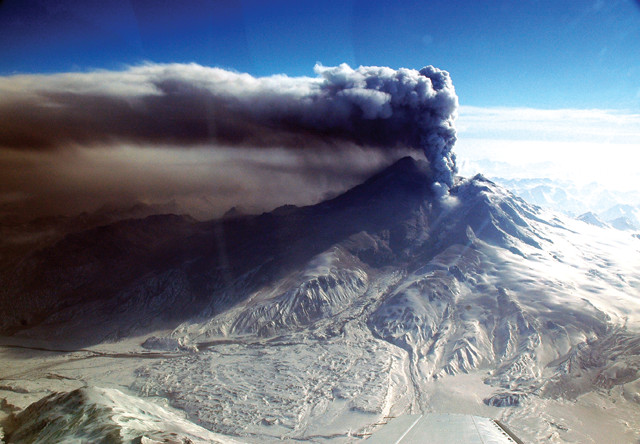
by Lucas Joel Tuesday, July 3, 2018

Volcanic eruptions, like those at Alaska's Redoubt Volcano, can generate seismic waves that researchers use to interpret Earth's interior. Credit: U.S. Geological Survey.
Geoscientists use the seismic waves produced by earthquakes to image the internal structure of the planet. Some seismic waves travel through liquids, while others do not, which is how we know, for instance, that Earth has a solid inner core and a liquid outer core. Scientists had thought they could use these properties of seismic waves to image the distribution of water within the planet, mainly water within the crystal structures of rocks. But in a new study, researchers reveal that may not be the case.
“It was a complete shock,” says Christopher Cline II, a graduate student in mineral physics at the Australian National University (ANU) and lead author of the new study, published in Nature. One reason such a basic characteristic of seismic waves — that they are not slowed by water — eluded discovery has to do with the scale of the problem: Most seismic waves have kilometer-scale wavelengths but recreating those wavelengths in the lab is a challenge. However, in the lab at ANU in which Cline works is a specialized setup that allows researchers to subject rock cylinders to the high pressures and temperatures found deep in Earth, and then torque one end of those cylinders in a way that creates forces and wave frequencies that mimic seismic waves.
Cline’s team tested both “wet” and “dry” rocks — those that have water in their mineralogical makeup, and those that do not. After subjecting both samples to similar pressures, temperatures and seismic waves, the researchers found no difference in the way the waves interacted with the rock. Cline says the result is the “nail in the coffin” for the idea that water causes large changes in seismic velocities.
Water was once thought to dampen, or slow, seismic waves, explains Geoffrey Abers, a geophysicist at Cornell University who was not involved in the new study. Waves would slow down because water was thought to reduce the strength of rocks, and, like a runner hitting quicksand, the waves would then slow down when they hit those rocks. When seismometers on Earth’s surface detected damped waves in the past, researchers typically thought they were indicative of the presence of water in regions of Earth’s interior through which they’d passed.
But now, Cline says, it seems that such damping may instead be a sign that the waves passed through molten rock.
The team also found that seismic waves are affected by the geochemical state of the rock they encounter. Minerals like olivine, the most abundant element in the upper mantle, can oxidize when subjected to the oxygenated conditions above subducting slabs and other settings in the mantle. When olivine oxidizes, the process creates microscopic defects in the mineral’s crystal structure — and these defects, Cline says, can also alter passing seismic waves.
The implications of this discovery for our understanding of Earth’s interior could be wide reaching. Water plays a key role in many subsurface processes, traveling back down into the mantle via subduction zones along with downgoing tectonic plates, and facilitating partial melting, which forms magma that rises and erupts from volcanoes. But using seismic waves to understand where and how much water might be in places like subduction zones and elsewhere may not be feasible, the researchers say.
“I would be surprised if [detecting] water was completely ruled out …[because] small amounts of water have a well-documented weakening effect on many materials, and numerous studies have quantified a huge effect on olivine,” Abers says. “But [these results are] giving us pause about how we’ve been interpreting this whole class of seismic data,” Abers says.
“While these new findings themselves [represent] drastic changes to our current mindset about how seismic energy propagates through Earth, what will be most exciting is when seismologists begin to use these data to interpret the structures they observe within Earth,” Cline says.
© 2008-2021. All rights reserved. Any copying, redistribution or retransmission of any of the contents of this service without the expressed written permission of the American Geosciences Institute is expressly prohibited. Click here for all copyright requests.